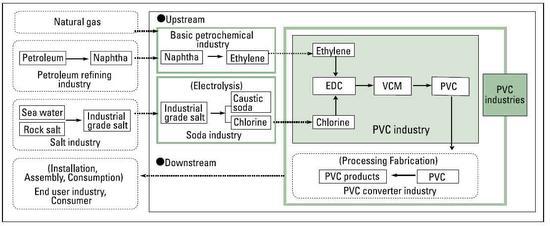The chemical process for making PVC involves taking the simplest unit, called the monomer, and linking these monomer molecules together in the polymerisation process. Long molecular chains are formed called polymers (which are also called macromolecules).
This is the case for PVC, which is made from vinyl chloride monomer known usually by its initials VCM through polymerisation. Some monomers exist in the form of reactive gaseous chemical substances, and some of these may cause health hazards when in direct contact with humans. In these cases they are manufactured and processed under strict control for health, safety and environmental protection.
On the other hand, polymers such as PVC, which are manufactured from monomers through polymerisation, are solid and chemically stable substances, therefore do not affect human health. VCM, which is the raw material for PVC, is a gas at ambient temperature but is usually stored in liquid form under pressure. Ethylene and chlorine are raw materials for PVC.
Upstream industries are those that provide these materials and include producers of basic petrochemicals (sometimes known as feedstocks’), which supply ethylene, and the chlor-alkali (caustic soda) industry, which supplies chlorine.

By thermal cracking of naphtha or natural gas, the basic petrochemical industry manufactures ethylene and propylene, etc. Naphtha is mainly supplied from the petroleum refinery industry, which uses crude oil as raw material. The chlor-alkali industry produces caustic soda, chlorine and hydrogen via electrolysis using industrial grade salt as main raw material.
At a first stage in the PVC production process ethylene and chlorine are combined to produce an intermediate product called ethylene dichloride; this is then transformed into vinyl chloride, the basic building block of polyvinyl chloride or PVC.
The process of `polymerisation' links together the vinyl chloride molecules to form chains of PVC. The PVC produced in this way is in the form of a white powder. This is not used alone, but blended with other ingredients to give formulations for a wide range of products.
The chemical process for making PVC involves taking the simplest unit, called the monomer, and linking these monomer molecules together in the polymerisation process.
Most commodity plastics have carbon and hydrogen as their main component elements. PVC differs by containing chlorine (around 57 per cent by weight) as well as carbon and hydrogen. The presence of chlorine in the molecule makes PVC particularly versatile because it makes it compatible with a wide range of other materials.
The chlorine content also helps to make PVC flame retardant. It can also be used as a `marker' to distinguish PVC in automatic sorting systems for plastics recycling. PVC formulations can be shaped by a variety of techniques and, using very little energy, made into the final product form. PVC polymer is chemically stable, neutral and non-toxic.
PVC formulations have a wide range of applications including the most sensitive, such as medical equipment, plus construction, automotive and electrical cabling.









